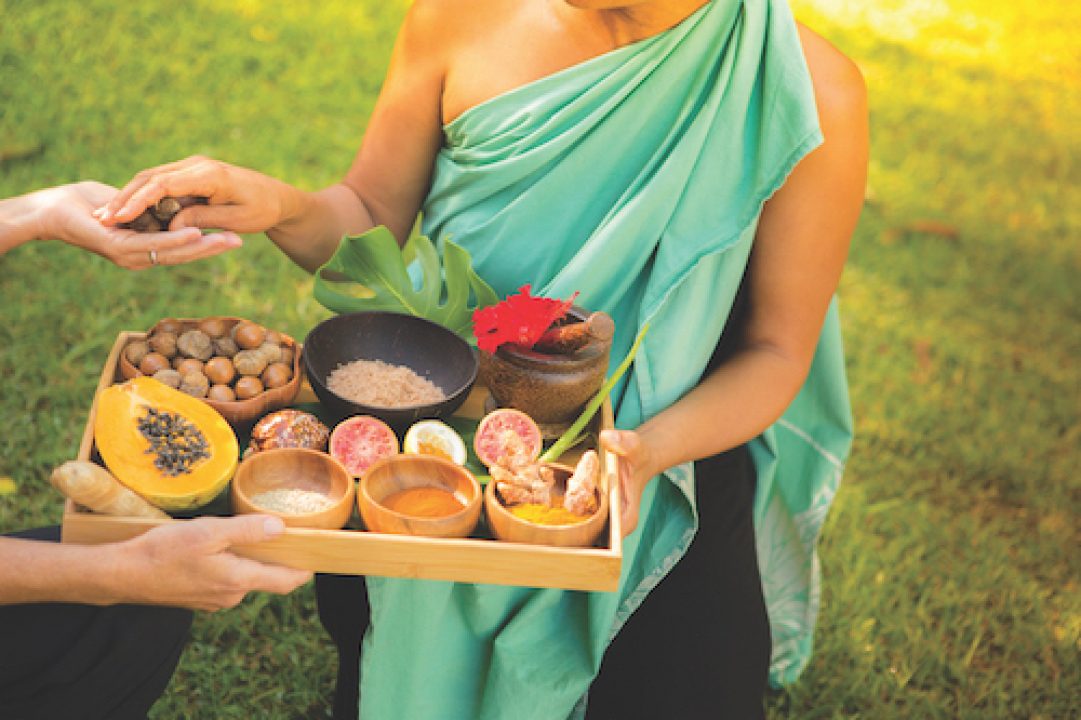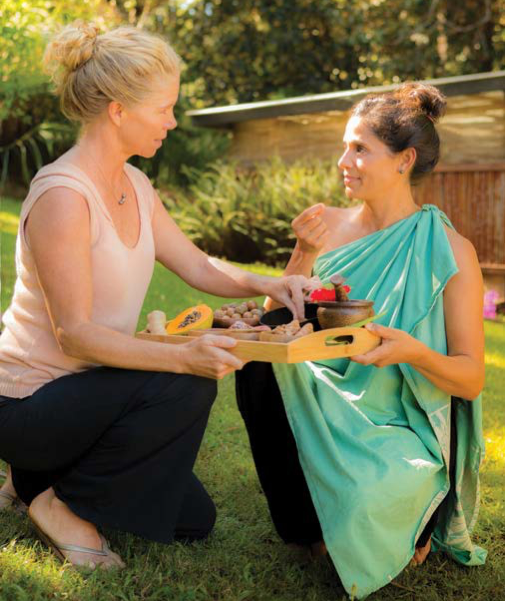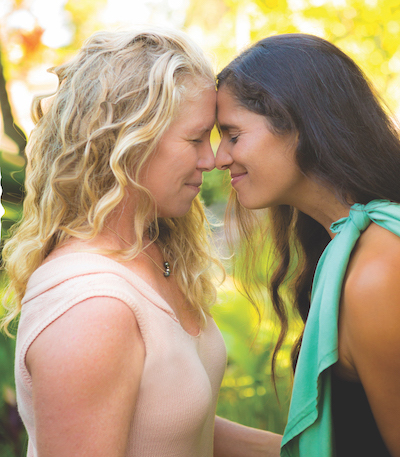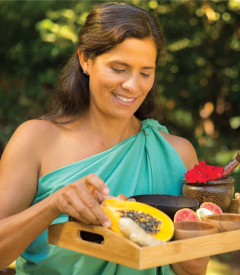
Caroline Woodham
Ancient teachings like Lomi Lomi and Ho’oponopono help heal modern hurts.
David showed up on Jeana Naluai’s table with severe back pain. He had been living with it for two decades. “Nothing has helped,” he explained to her.
David was there to learn lomi lomi, a traditional Hawaiian healing practice. He agreed to be open, and she began asking questions about his past, his relationship with his family, and life choices he had made.
Years earlier, he had given up his dream of becoming a massage therapist to follow a family expectation of going into the military. While serving, he injured his back. As Naluai continued to ask about his relationships and family, David began to understand his life in a different light. The grip of his back pain released.
‘That Ancient Song’
Though often offered as purely a physical massage, the roots of lomi lomi extend much deeper. This type of work descends from the practice of “lovingly massaging the body of your loved one who has passed away,” explains Naluai, who shares Hawaiian cultural healing practices with students around the world and hosts trainings and retreats at her spa on the island of Maui.
She explains that the practice she teaches is rooted in the original. “We are lovingly massaging the person on the table, connecting soul to soul, lineage to lineage, and we are imagining they are like family, like our mother, grand- mother, aunt, uncle, or child, and we are assisting them to the next place on their healing journey.”
This recognition of family is sometimes missed when lomi lomi is taught in a short weekend workshop. A piecemeal or abbreviated approach to sharing cultural traditions can water them down until they no longer resemble the original teachings. Despite this, Naluai feels called to spread the practice, trusting her students to work toward a deep understanding.
Margaret Machado was one of the first to bring lomi lomi to non-Hawaiians. This was in the 1980s, and it created a backlash within the community. Her vision, however, was that the knowledge was meant to be shared. Naluai studied with Machado.
“It wasn’t one of our original concepts to believe that the land was ours,” Naluai says, “or to think that we had to keep the knowledge to ourselves. There was lineage and the way that we pass knowledge forward: We watch and we listen to who is going to carry it forward, but the idea that we had to keep the knowledge secret was something that was conditioned over time, and I think it’s based in fear.”
That fear stems from the land being taken from the Hawaiian people, and also from the Hawaiian culture being oppressed under colonial rule.
“One of my teachers, Kumu Mike Lee, was an observer, a timekeeper who looked at the symphony of how everything works together, from the mountains to the sea, and everything in it, and within that is our connection to source and our stewardship of the land. He said, ‘Hawaii has this model that can heal the land, the water, the air, and the ocean. If we keep it to ourselves, there’s no point. Others can learn from what we’ve been doing that is sustainable for thousands of years.’”
There is an overarching and continuous thread that weaves through the tapestry of Hawaiian cultural practices. It is a thread of connection: to each other, to family, to community, to the spiritual world, and to the land. It allows access to a kind of knowing that is deeply rooted in the ancient knowledge of interdependence.
Individuals must take responsibility for themselves, but there is as much emphasis placed on being responsible to the family, to the community, to the land, and to the ancestors who came before. When there is disharmony in the thread, illness and pain are often a result.
The Western perspective is often one of separation. There is a tendency to pull apart the whole in an effort to find a solution to an illness or the source of pain. “The
Hawaiian concept of wellness,” explains Naluai, “has to do with your family; generational things need to be healed.
It isn’t just the people in your family. It includes the land, and how you steward the land. If you really want to heal the people, you plug them back into their land, and you help to heal the whole family.”
Without the stories that have been passed down through generations and the sharing of the totality of the practice, it becomes merely a shadow of what it is meant to be. “I think one of the problems you come up against when you try to teach something indigenous to a Western culture is that the concept of lineage has been diluted,” says Naluai.
Naluai began getting invited to teach lomi lomi to groups around the world over a decade ago. When she teaches in cities, particularly throughout Europe, her students often lament that they feel disconnected from their roots and from their land. She describes teaching in Spain and learn- ing from her students how disconnected they felt ancestrally. Later that day they attended a festival of San Juan, where they participated in a burning ritual and a song:
Abuelito Fuego,
Grandfather Fire, we give thanks to you.
Abuelita Agua,
Grandmother Water, we give thanks for opening our
hearts and opening us to healing.
“Listen to that song,” Naluai told her students. “You have these ancient songs that everyone in your entire country knows. It’s something you have been singing forever. That connection to the indigenous mindset isn’t lost, it’s just about remembering it.”
Naluai told the students they can connect to their culture through chant, through ritual, through communion with nature, and through connection with each other. “Everybody has a root to that ancient song.”
Naluai explains, “I feel like what we’re doing, and what our teachers did for us, is activating the remembering that’s in our DNA, in our bones. My mission is not to have someone adopt Hawaiian culture. My mission is about helping to activate that knowing and remembering in someone else, to explore their culture, their ancestors, and their roots.”
Naluai explains that as humans we are all one family. The timeline of what happened in Hawaii, from the time of chiefs, to colonization, to modernization, is a timeline that everyone around the globe shares.
She describes being in Ireland, where she felt that her students had a powerful recognition of a common history. “Because,” Naluai says, “it’s always been that someone thought they were better and more powerful than you, wanted something that you had, and decided to take it from you.”
The timeline shows a common theme of spiritual and emotional violence that broke indigenous cultures down and made them feel ashamed of their cultural practices. This commonality is one of the reasons Naluai feels it is so important to share healing practices as widely as possible.
“Everybody that’s coming to lie on the table, no matter where they are from, they are walking around with these same stories that require the very same empowerment.”
A Path to Freedom
Ho’oponopono is a Hawaiian practice of both forgiveness and of taking responsibility. It is a spiritual cleansing practice that is meant to make things right between individuals and within the community. Ultimately, it is about freedom, and unraveling yourself from the web of disharmony that you think was caused by others.
In the context of lomi lomi, ho’oponopono begins to address the spiritual wounds that are often at the core of physical pain. Many people first heard of ho’oponopono through the book Zero Limits by Joe Vitale. He shared a version that essentially is built on four phrases:
- I love you
- I’m sorry
- Forgive me
- Thank you
This is just one version of ho’oponopono, one that comes from a particular lineage. It is a modern take on a traditional practice, but it is oversimplified; easily accessible, but missing some of the deeper roots.
Naluai describes ho’oponopono as the practice of being in alignment with yourself, with others, and with the divine.
“As we go through life, we are faced with different challenges; we bump up against each other. Through that process, over time, we can smooth out some of the rough edges of life’s learning curve. One of my teachers said it means to make right more right.”
Naluai continues: “We are constantly evolving in our being: learning, growing, and expanding. Every situation and obstacle that comes along, no matter how challeng- ing, is actually still perfect. It’s already right, but it can be improved. An elder can always be learning from a child, no matter how many years they have been wisdom keepers.“
Naluai grew up in a family that used ho’oponopono to address conflict. The family would gather. One person was the leader, the mediator. That person was spiritually connected and thought to be a medium between the realms.
“When someone had something that was upsetting them, there was the understanding that we are just a product of a continuum—backwards and forwards—not just the people who are in the circle. We would open in prayer and invite our ancestors in because sometimes the burdens we are carrying belong to them. We want to invite them in to have that lifted away as well. Often when conflict occurs it’s because we are bringing past hurts, either from this life or things passed on from our ancestors.”
Naluai explains that after a prayer, each person would share their perspective on the problem, “how to get to the source of the work.” Only then would each person share what they thought was a reasonable solution.
“This could take a long time because you would go around the circle until everything had been said,” she remembers. “You would also ask for forgiveness, an aspect of taking responsibility.” A period of silence allowed every- one to think, but also was “a symbol of your commitment to never speak of it again outside of the circle, so the energy you’ve released doesn’t just jump right back in.”
“Then we would close with prayer,” she says, “and it would close the time of the sacred. Food brings you back from the spirit place, and since we had opened the portal for the ancestors to be with us, we would close it by eating together.”
“Aunty Mahilani Poe Poe,” Naluai says, “who was my primary teacher and my foundation in this work, would share that where your thoughts go, energy will flow. When we share outside of the ho’oponopono circle, or when we continue to tell the story of our trauma over and over, it perpetuates disharmony and gives mana, or more life force, to our discontent.
Ho’oponopono can also be practiced by individuals as a way of “looking at what you have taken in that you have not yet digested.”
Naluai explains, “When you are feeling irritated with something, it’s because you have something you’re carrying that is still as of yet undigested. You need to take a look at it and clear it out.”
She shares a shortened version of the parable of the bowl of light from a book called The Tales from the Night Rainbow by Pali Jae Lee and Koko Willis:
Each child is born with a bowl of perfect light. If the child tends the light, it will grow in strength and he can swim with the sharks, fly with the birds, and know and understand all things. But if he goes upon his path of life and becomes envious, jealous, fearful, or angry, each of these emotions is like a stone that he places in his bowl of light. As a result, some of the light goes out because the stone and the light cannot hold the same space. If he continues on this path, he becomes heavy like a stone; a stone cannot move, and a stone cannot grow. But if at any time he tires of being a stone, all he needs to do is turn his bowl upside down, the stones will fall away, and his light will shine once more.
Naluai explains that the bowl of light is “your spirit, your spiritual connection. It’s you and all of your gifts.” As old, undigested stories age within the bowl, they become more powerful, heavier and heavier. “It has to do with what you’re carrying, and not the other person,” she emphasizes.
She has brought the wisdom from this story into a meditation that she shares with her students.
Visualize that bowl of perfect light shining bright with all the gifts of your spirit. Take a look inside and see if there’s anything you are carrying that doesn’t belong there. Is there anything that is unresolved that perhaps it’s time to release or let go of?
If there is, eject that stone from your bowl of light and surround yourself, the situation, and whoever else was involved, with aloha. Send it out to the universe or the deep ocean, and ask for help from the ancestors and from spirit. Now you have this empty space in your bowl of light. Rather than leaving it open for the same stone to return, put something in there that you desire, that you want. What is the opposite of what you were carrying?
If you were carrying impatience, release it and bring in a knowledge and a trust that everything is happening in perfect right timing. Keep telling yourself that, because it’s a practice. Over time, the things that would have bothered you no longer do. There’s no room for that energy to be around you. You’ve raised your vibration with the light that you’re carrying, and the stone and the light cannot hold the same space.

Jeana Naluai with author Kalia Kemelson. Photos by Caroline Woodham
Thinning the Veils
It was shortly after sunset when I opened the door to Jeana. She hugged me and I welcomed her into my home. She entered carrying her massage table and was followed by four other women, all carrying their tables as well.
I had pushed the furniture in my living room to the side and they quietly set their tables throughout the space. They unloaded wooden bowls filled with stones and sacred ti leaves, sea salt, and ocean water. I lay down on Jeana’s table, and my brother, sister mother, and uncle lay down on the other tables.
As we settled ourselves on the tables, the women in the room began to chant an ancient prayer. I could feel the vibration of their voices to my core, and it felt as if the air in the room shifted. As they began their work, massaging our grieving bodies, using hot stones to soften and mold our tissues, I felt the tension and strain of the previous days begin to melt.
It had been four days since the sudden death of my father by his own hand. Still reeling from the shock of it, I had been stumbling through the necessary steps as if in a fog. I wanted to somehow under- stand, to make meaning of the indescribable pain I felt.
On Jeana’s table, I began to sob as she held the space for the unwinding. The candle-lit room held a kind of shimmer, a thinning of the veil that separates our world from that of the spirits. The voices of the women lifted into a song; Hawaiian words that invited the healing to sift through the realms, through our bodies, to everywhere it was needed.
I felt as if some of the emotional burden I was carrying was lifted that night. It allowed me to know that place of connection to spirit, to understand that it is always available to me. It allowed me to access my father’s love and to have compassion for his pain.

‘A Universal Message’
Meggie Walsh is one of Naluai’s students. She grew up in Germany and now translates the teachings of lomi lomi and teaches internationally with Naluai. She originally struggled with how to share the wisdom in an authentic and potent way, wondering if in the passing of the practice, it would be diluted.
“There are hours of ‘talk story’ in all of the classes, which involves telling stories, Hawaiian wisdom, and the timeline,” Walsh explains. “To be able to share the wisdom in another language, I had to take it
in at a very deep level, completely understand it; to really digest it so that I could share it in an authentic way.”
Walsh explains that, “For me, when I’m sharing lomi, it is about staying very close to those lineage teachings and not putting my own twist to it. That way, I always have something to go back to, to understand where exactly the practice is coming from.”
The rituals that are shared with the students, from cleansing to calling in the ancestors, are the same ones used in Hawaii and are part of what roots the teachings. They often involve plants and stones from the land. “When we are teaching abroad,” says Walsh, “we sometimes will use implements found from the land we are teaching on.” It is a way of staying rooted to the sense of place. Those plants and stones carry the mana, or life force, of the land from which they came.
What has been most impactful for Walsh, and what has kept her so deeply rooted, is the call for this work, the desire for healing from every place she visits around the world. “It is a universal message,” says Walsh, “it is needed everywhere.











